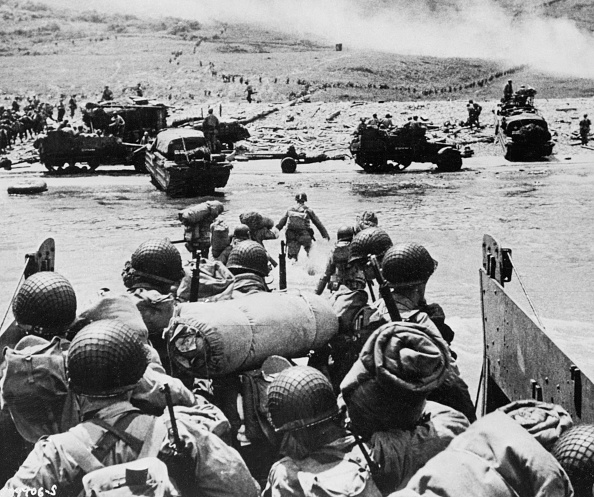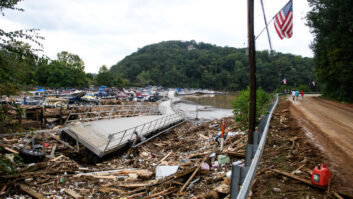The Allied invasion of continental Europe 80 years ago was a logistical tour de force. Its success hinged on an operative communications network unifying the invading armies and their support systems.
The U.S. Army Signal Corps, or “SigC,” was tasked with establishing massive, reliable, multi-channel high-speed voice and “data” networks. These networks would support a mission buildup of more than a million troops in a hostile environment.
That meant two-way voice circuits to keep decision-makers in touch and high-speed channels to exchange reconnaissance photos and situation maps evaluating the impact of aerial and ship-launched ordnance.
SigC’s design baselines were high capacity and agility, with low latency. Communications with the beach had to be established speedily using whatever gear made it to shore in the contested landings. The system had to be mobile: radio supplemented by ad-hoc wire telephony. Contact within operating units had to survive when troops mistakenly landed in one another’s sectors.

Frequency coordination
SigC had estimated it would need some 90,000 transmitters for the job. This mandated frequency coordination. The radios were largely short-range “hand-helds” but also included short- and medium-distance radio links to naval and air elements and Allied headquarters.
Signal-gear manufacturers were asked to provide rollout proposals for the project and it quickly became apparent that the total number of required radio channels was far larger than the spectrum available (2.5 to 8 mc). SigC’s last-minute solution was to narrow the guard bands between channels to as little as 4 kc. Fortunately, tactical radios had been designed for crystal-controlled FM operation so this predicted project snafu was resolved by last-minute crystal-regrinding on a massive scale.
In the end, it all worked. In the first three weeks of the invasion, among all those transmitters, only 80-some interference complaints were registered.
A significant amount of radio gear was lost in the initial landings but SigC’s planning had suitably provided for battle attrition. Contact with the beach was generally successful, with the exception of some high-power voice-channel transmitters delayed through circumstance.

Trivia: Less susceptible to battle damage were some 500 pigeons, landed for the purpose of carrying ammunition-status reports, undeveloped film and emergency messages. At the end of the day, electronic communications were so effective the pigeons could go home to roost.
The “backhaul”
No less important than unit tactical communications was the need for reliable high-capacity communications with headquarters in Britain.
Initial contact relied on shore-based transmitters reaching off-shore relay ships for retransmission to England. Shortly after operations began, a SigC team successfully established multi-channel “carrier” systems (Army/Navy Transportable Communications, or ANTRAC) directly from France to England. And by the end of June, surviving an initial series of setbacks, cable ships were able to lay wire communications across the channel.

Media matters
The relatively “thin-route” requirements for the media were not lost in the planning. Fortunately, key military leaders remained aware of the need to keep the world informed. Media support had failed somewhat sadly in the North African Invasion of 1942 and it was clear that SigC had to do a better job.
David Sarnoff of RCA was appointed by General Dwight Eisenhower to coordinate media communications planning. Sarnoff’s efforts resulted in the establishment of a media route through the “London Signal Center,” itself the hub of SigC communications. And Sarnoff was able to leverage his high-level relationships to induce the British to establish additional shortwave paths to America.
In the months preceding the invasion, American journalists had been facing implied and actual opposition from the British, who didn’t understand Americans’ incessant demands for information. As an early demonstration of how the show would be run, SigC established “FAX,” its own full-duplex shortwave channel direct to the United States. FAX would become the official channel for communiques from SHAEF, the Supreme Headquarters, Allied Expeditionary Force. FAX would also cue the radio networks tied to it in a “party-line” arrangement.
In turn, the media had to accept certain ground rules. Given that very few journalists were authorized a seat in the initial show, radio reporting would be pooled, coordinated by Edward R. Murrow. Print copy had to be shared among all competitors and recording of radio news reporting was for the first time allowed by the American networks.

America waits for the news
In anticipation of the invasion and in the spirit of pool coverage, the radio networks came together in temporary harmony to prepare for “the biggest news story of the decade.” Rival news directors met to coordinate coverage and to help one another with planning difficulties.
The ultimate vigil began early on the morning of June 6 when German Radio announced “an invasion of France.” The network newsrooms turned up the volume on the FAX circuit and waited for confirmation. The first official communique came through about 2:30 a.m. From then on, it was a matter of watching the teletype and waiting for pool reports.
Observing the invasion, some journalists aboard ships or aircraft would make their recordings or write their copy en route; they’d disembark back in England and make a beeline for Britain’s Ministry of Information for review and censorship clearance. (Recordings were made on some form of “sound film,” since ship and aircraft motion made traditional disc-recording impossible.)

From the battleground itself, radio reporters spoke into “transcription machines” of varying complexity. These recordings were then shipped to London on naval transport (and often subjected to unforeseen delay). Some reports made it to London via air on the “SHAEF Shuttle.” Once cleared by the censors, the recordings and any live reporting from studios in England were forwarded to shortwave transmitters.
The written media would soon find a pipeline to America direct from the beaches. Two selected commercial companies, Press Wireless and Mackay Radio, were to establish circuits from the continent to the United States. Press Wireless was to become operational on D+60 and Mackay Radio on D+90, but under serious pressure from the press and through a “test arrangement” with SigC, the Press Wireless transmitter came up early.
Its “direct-to-America” capability at first created a censorship ruckus but eventually, under press pressure, the military cleared the way for the hundreds of thousands of words destined for American newspapers. The radio recordings contributed to the legacy of wartime journalism.
D-Day coverage was known by journalists as “The Biggest Beat,” and history records its success. But the valor and sacrifice of the soldiers landing on those beaches would be the biggest story and would far outstrip the work of the deskbound planners.
Comment on this or any story to radioworld@futurenet.com. Reach the author at mark4@durenberger.com.







